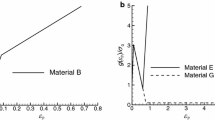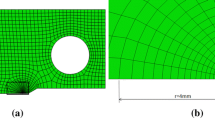Abstract
A mechanical and optical characterization study in a uniaxial field was conducted on a commercial di-phase photoelastic material suitable for stress freezing. Results were used in a plane-strain theory for predicting nonlinear crack-tip behavior with the Prandtl-Reuss equations and a Mises criterion. These predictions were compared with frozen-stress photoelastic results obtained from experiments on a variety of technologically important three-dimensional cracked-body problems. Results indicate substantially greater stiffness or constraint in the nonlinear zone near the crack tip than predicted using uniaxial data. However, the value of the maximum shear stress at the onset of nonlinear behavior was accurately established and was the same for all cases examined.
Similar content being viewed by others
Abbreviations
- n, t, z :
-
local rectangular Cartesian coordinates along the flaw border
- σ ij i,j=n,z :
-
stress components in plane normal to the flaw surface and flaw border near crack tip (kPa)
- σ ij o i,j=n,z :
-
part of regular stress field near crack tip (kPa)
- r, θ:
-
polar coordinates, measured from crack tip (mm, rad)
- K I :
-
Mode I — stress-intensity factor (kPa-m1/2)
- K II :
-
Mode II — stress-intensity factor (kPa-m1/2)
- K AP :
-
Mode I — apparent stress-intensity factor [τ max (8\(\pi r)^{1/2} \)] (kPa-m1/2)
- a :
-
characteristic crack depth (mm)
- τ max :
-
maximum shear stress inn−z plane (kPa)
- N′:
-
stress-fringe order
- f :
-
material-fringe value (N/m)
- t′:
-
slice thicknes in thet direction (mm)
- q :
-
remote loading parameter (i.e. uniform stress, pressure, etc.) (kPa)
- E :
-
Young's modulus (kPa)
- σº :
-
proportional-limit stress (kPa)
- α:
-
material constant
- N :
-
hardening exponent
- δe :
-
effective stress (kPa)
- ∈1 :
-
total strain (mm/mm)
- γe :
-
maximum shear strain (rad)
- G :
-
shear modulus (kPa/rad)
- σ rs rs,=1,2,3:
-
stress components (kPa)
- ∈ rs rs,=1,2,3:
-
strain components (mm/mm)
- σ e :
-
effective stress (kPa)
References
Sih, G.C., Handbook of Stress Intensity Factors for Researchers and Engineers, Inst. Fracture and Solid Mechanics, Lehigh University, Bethlehem, PA (1973).
Tada, H., Paris, P.G. andIrwin, G.R., The Stress Analysis of Cracks Handbook, Del Research Corp., Providence, RI (1973).
Rooke, D.P. andCartwright, D.J., Compendium of Stress Intensity Factors, Pendragon House, Palo Alto, CA (1976).
Sneddon, I.N., “The Distribution of Stress in the Nieghborhood of a Crack in an Elastic Solid,”Proc. Royal Soc., Series A,187,229–260 (1946).
Green, A.E. andSneddon, I.N., “The Distribution of Stress in the Neighborhood of a Flat Elliptical Crack in an Elastic Solid,”Proc. Cambridge Phil. Soc.,46,159–163 (1950).
Shah, R.C. and Kobayashi, A.S., “On the Surface Flaw Problem,” The Surface Crack: Physical Problems and Computational Solutions, ASME Sp. Pub. Comm. for Computing in Appl. Mech., Appl. Mech. Div., 79–124 (1972).
Rybicki, E.F. and Benzley, S.E., eds., Computational Fracture Mechanics, ASME Sp. Pub. Computer Tech. Comm. of the Pressure Vessels and Piping Comm., 1, 21, 35, 49, 63, 103, 173, 185 (1975).
Sih, G.C., Mechanics of Fracture 2—Three-Dimensional Crack Problems, Noordhoff Int., Leyden, The Netherlands (1975).
Cruse, T.A., “Numerical Evaluation of Stress Intensity Factors by the Boundary-Integral Equation Method,” The Surface Crack: Physical Problems and Computational Solutions, ASME Sp. Pub. Comm. for Computing in Appl. Mech., Appl. Mech. Div., 153–170 (1972).
Smith, F.W., “The Elastic Analysis of the Part Circular Flaw Problem by the Alternating Method,” The Surface Crack: Physical Problems and Computational Solutions, ASME Sp. Pub. Comm. for Computing in Appl. Mech., Appl. Mech. Div., 125–152 (1972).
Atluri, S.N. and Kathiresan, K., “An Assumed Displacement Hybrid Finite Element Model for Three-Dimensional Linear Fracture Mechanics Analysis,” Proc. 12th Annual Mtg. Society of Engineering Science, 77–87 (Oct. 1975).
Wilkins, M.L., “Fracture Studies with Two and Three Dimensional Computer Simulation Program,” (In press) Proc. Int. Conf. Fract. Mech. and Tech., Hong Kong (1977).
Pian, T.H.H., “Hybrid Models for Three-Dimensional Crack Elements,” Battelle Workshop on 3D Fracture (April 26–28, 1976).
Oppel, G., “Photoelastic Investigation of Three Dimensional Stress and Strain Conditions,” (Translation by J. Vanier),NACA TM 824 (1937).
Irwin, G.R., Discussion, Proc. SESA,16 (1),92–96 (1958).
Bradley, W.B. andKobayashi, A.S., “An Investigation of Propagating Cracks by Dynamic Photoelasticity,”Experimental Mechanics,10 (3),106–113 (Mar. 1970).
Bradley, W.B. andKobayashi, A.S., “Fracture Dynamics—A Photoelastic Investigation,”J. Engrg. Fract. Mech.,3 (3),317–332 (Oct. 1971).
Jolles, M., McGowan, J.J. and Smith, C.W., “Use of a Hybrid, Computer Assisted Photoelastic Technique for Stress Intensity Determination in Three Dimensional Problems,” Computational Fracture Mechanics, Proc. 2nd Natl. Cong. Pressure Vessels and Piping, 83–102 (Jun. 1970).
Smith, C.W., “Use of Three-Dimensional Photoelasticity in Fracture Mechanics,” Proc. 3rd Int. Cong. Experimental Mechanics, 287–292 (Dec. 1974).
Marrs, G.R. andSmith, C.W., “A Study of Local Stresses Near Surface Flaws in Bending Fields,”Stress Analysis and Growth of Cracks,ASTM STP 513,22–36 (Oct. 1972).
Schroedl, M.A. andSmith, C.W., “Local Stresses Near Deep Surface Flaws Under Cylindrical Bending Fields,”VPI-E-72-9 Progress in Flaw Growth and Fracture Toughness Testing,ASTM STP 536,45–68 (Oct. 1973).
Schroedl, M.A., McGowan, J.J. andSmith, C.W., “Determination of Stress-intensity Factors from Photoelastic Data with Application to Surface-flaw Problems,”Experimental Mechanics,14 (10),392–399 (Oct. 1974).
Harms, A.E. andSmith, C.W., “Stress Intensity Factors for Long, Deep Surface Flaws in Plates Under Extensional Fields,”VPI-E-73-6, (Feb. 1973).Recent Developments in Engineering Science,7,59–66 (1976).
McGowan, J.J. andSmith, C.W., “Stress Intensity Factors for Deep Cracks Emanating from the Corner Formed by a Hole Intersecting a Plate Surface,”Mechanics of Crack Growth,ASTM STP 590,460–476 (1975).
Smith, C.W., McGowan, J.J. and Jolles, M., “Stress Intensities for Cracks Emanating from Holes in Finite Thickness Plates by a Modified, Computer Assisted Photoelastic Method,” Proc. 12th Annual Mtg. Soc. Engrg. Sci., Austin, TX, 353–362 (1975).
Jolles, M., McGowan, J.J. andSmith, C.W., “Experimental Determination of Side Boundary Effects on Stress Intensity Factors in Surface Flaws,”J. Engrg. Mats. and Tech., ASME Trans. 97 (1),45–51 (Jan. 1975).
Smith, C.W. and Jolles, M., “Stress Intensities in Deep Surface Flaws in Plates Under Mode I Loading,” Dev. in Theo. & Appl. Mech. (Proc. 8th SECTAM), 151–161 (1976).
Smith, C.W., Jolles, M. and Peters, W.H., “Stress Intensity Determination in Three-Dimensional Problems by the Photoelastic Method,” Proc. 2nd Int. Conf. Mechanical Behavior of Materials, 235–240 (1976).
Jolles, M., McGowan, J.J. andSmith, C.W., “Effects of Artificial Cracks and Poisson's Ratio Upon Photoelastic Stress-intensity Determination,”Experimental Mechanics,16 (5),188–193 (May 1976).
Smith, C.W., “Stress Intensity Estimates by a Computer Assisted Photoelastic Method,” Proc. Int. Conf. Fract. Mech. and Tech., Sijhoff and Noovdhoff, Alphen den Rijn, The Netherlands,II,591–606 (1977).
Smith, C.W., Jolles, M. and Peters, W.H., “Stress Intensities in Flawed Pressure Vessels,” Pressure Vessel Technology — Part II, Materials and Fabrication (Proc. 3rd Int. Conf. Pressure Vessel Tech.), 535—544 (Apr. 1977).
Smith, C.W., Jolles, M.I. and Peters, W.H., “Geometric Influences Upon Stress Intensity Distributions Along Reactor Vessel Nozzle Cracks,” Trans. 4th Int. Conf. Struct. Mech. in Reactor Tech., Structural Analysis of Steel Reactor Pressure Vessels,6,Paper No. G4/3 (Aug. 1977).
Smith, C.W., Jolles, M. andPeters, W.H., “Stress Intensities for Nozzle Cracks in Reactor Vessels,”Experimental Mechanics,17 (12),449–454 (Dec. 1977).
Smith, C.W., Jolles, M.I. andPeters, W.H., “Stress Intensities for Cracks Emanating from Pin Loaded Holes,”Flaw Growth and Fracture,ASTM-STP 631,190–201 (1977).
McGowan, J.J. andSmith, C.W., “A Finite Deformation Analysis of the Near Field Surrounding the Tip of Crack Like Elliptical Perforations,”Int. J. Fract.,11 (6),977–987 (Dec. 1975).
Smith, C.W., Jolles, M. andPeters, W.H., “Stress Intensities for Nozzle Cracks in Reactor Vessels,”VPI-E-76-25, ORNL/Sub/7015-1 Dist. Cat. NRC5 (In press).Experimental Mechanics,17 (12),449–454 (Dec. 1977).
Hutchinson, J.W., “Plastic Stress and Strain Fields at a Crack Tip,”J. Mech. and Phys. of Solids,16,337 (1968).
Rice, J.R. andRosengren, G.F., “Plane Strain Deformation Near a Crack Tip in a Power Law Hardening Material,”J. Mech. and Phys. of Solids,16,1 (1968).
McGowan, J.J. andSmith, C.W., “A Plane Strain Analysis of the Blunted Crack Tip Using Small Deformation Plasticity Theory,”Advances in Engrg. Sci.,2,585 (Nov. 1976).
Aurich, D., Helms, R., Schmidt, P., Veith, H. and Ziebs, J., “The Influence of the Stress State on K IC ,” Paper No. G5/2, Trans. 4th Int. Conf. Struct. Mech. in Reactor Technology (Aug. 1977).
Author information
Authors and Affiliations
Additional information
J. J. McGowan was Assistant Professor in same department at VPI & SU
Rights and permissions
About this article
Cite this article
Smith, C.W., McGowan, J.J. & Peters, W.H. A study of crack-tip nonlinearities in frozen-stress fields. Experimental Mechanics 18, 309–315 (1978). https://doi.org/10.1007/BF02324162
Received:
Revised:
Issue Date:
DOI: https://doi.org/10.1007/BF02324162




